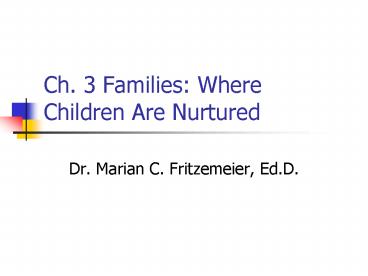Ch' 3 Families: Where Children Are Nurtured - PowerPoint PPT Presentation
1 / 23
Title:
Ch' 3 Families: Where Children Are Nurtured
Description:
The definition of a family has been broadened to include new forms: ... Extended family: nuclear family ... Connect with posterity; honor elders (pp. 40-41) ... – PowerPoint PPT presentation
Number of Views:38
Avg rating:3.0/5.0
Title: Ch' 3 Families: Where Children Are Nurtured
1
Ch. 3 Families Where Children Are Nurtured
- Dr. Marian C. Fritzemeier, Ed.D.
2
- DUE Tonight Interview with a School-Age
Professional - DUE Tonight Cultural item
- Sign-ups tonight for research topics
3
The Changing Family
- The definition of a family has been broadened to
include new forms - Nuclear family mother, father, children
- Extended family nuclear family plus other
relatives - Single-parent either mother OR father children
(p. 35)
4
- Reconstituted or blended remarriages that
include his and/or her children plus theirs - Interracial mother father from different ethic
groups their children families that include
adopted children of another racial or ethnic
group (p. 35)
5
- Single-gender same sex couples their
biological or adopted children - Grandparent only adult when both parents are
deceased, incarcerated, on drugs, or otherwise
unable to care for children - Foster (Not in text)
6
Effects of home environment on children
- Two-parent families, even if both work
- Advantages
- Children have fewer problems, do better in
school, less likely to use drugs or get arrested
when teenagers - two adults share child-rearing tasks
- additional income if both work
- mother is a role model (pp. 36-37)
7
- Disadvantages
- When both parents work
- More stress on parents
- Not enough time
- Children may feel abandoned (p. 37)
8
Single-parent families
- Single-mother feelings of loss, lack of special
kind of child rearing rather provide, low or
decreased income - Single-father fathers have custody of children
by their own wish, children respond well to male
as an authority figure, income likely to be
better (pp. 38-39)
9
Reconstituted families
- Economic situation improves
- Boys helped by presence of father
- Father may share more in child rearing
- More models to choose from (p. 39)
10
Interracial families
- Children may have problems with self-esteem
- Be targets of discrimination
- Have problems developing their own identity (pp.
39-40)
11
Single gender
- Target of discrimination
- Children may consider themselves different from
schoolmates (p. 40)
12
Living with Grandparent(s)
- Additional stress on adults children
- Children may have more behavior problems
- Poorer language skills
13
Brainstorm
- Brainstorm and create a list of family-related
factors that contribute to a healthy child or
adolescent
14
Successful Families
- Affectionate express love care
- Sense of place stable environment
- Pass on cultural heritage
- Connect with posterity honor elders (pp. 40-41)
15
- Promote perpetuate family rituals pass on
traditions that encourage sense of family
continuity - Communicate with one another
- Respect differences among their members (p. 41)
16
Large Group Sharing
- Student Activity, p. 46, 3 sharing of cultural
items - Think about what you are learning about your own
cultures and/or other cultures
17
Sign-ups for Research Presentations
18
Poverty
- Almost 14 million children live in families whose
income is considered below the poverty line - Likely to suffer from problems (p. 41)
19
Health Problems
- Malnutrition disease
- Abuse and/or neglect
- More frequent injury or death from accidents
- Exposure to lead poisoning (p. 41)
20
Academic Problems
- May be behind in academic achievement because
their schools are poorly equipped maintained - Class sizes are large
- Teachers are poorly paid under motivated (p. 41)
21
Psychological problems
- Children view themselves unfavorably when
compared with those they see portrayed in films
or on television - Neighborhoods are run-down dangerous
- Develop feelings of hopelessness depression (p.
41-42)
22
Small Groups Helping Children Their Parents
- Group 1 Communicate with parents (p. 42)
- Group 2
- Help parents see children's behavior
- Encourage parents to use knowledge to bring about
changes (p. 44) - Group 3 Parents anger fatigue (p. 44)
- Group 4 Families sharing cultural ethnic
traditions (p. 44)
23
Graphic Organizers
- Title
- Most important points with key words or phrases
(NO SENTENCES!) - Drawings that correspond with information































